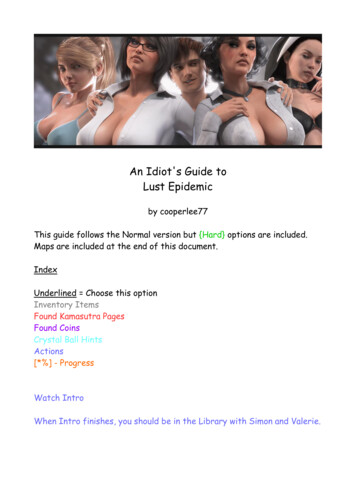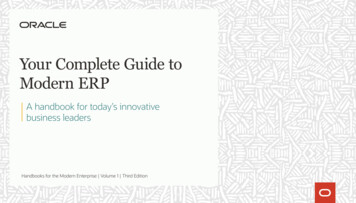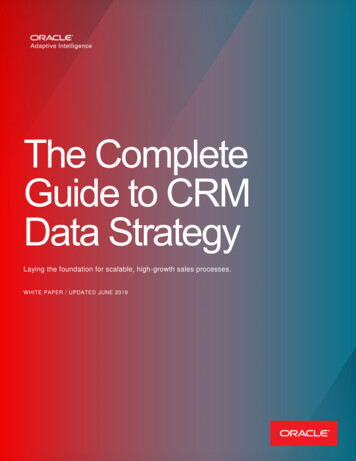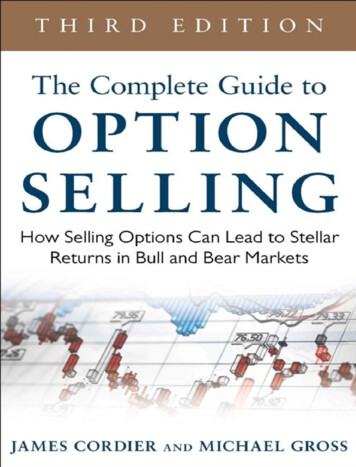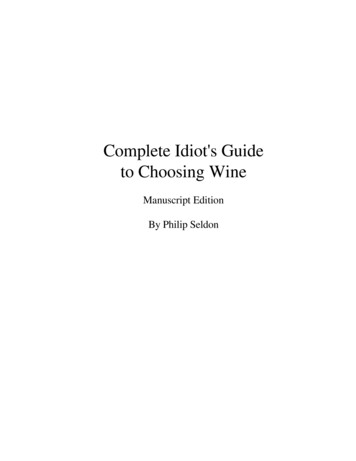
Transcription
Complete Idiot's Guideto Choosing WineManuscript EditionBy Philip Seldon
ABOUT THE AUTHORPhilip Seldon had his first taste of wine at age five at the traditional Passoverseder. The wine was sweet kosher wine (not the kind of wine subject of thisbook) and watered down but nevertheless delicious. From this firstintroduction, came a lifelong fascination with wine that has made him a leadingfigure on the international wine scene. In the mid 60’s he drank his way throughthe classified growths of Bordeaux and the Premier and Grand cru of Burgundywith abandon as they were extremely inexpensive the and thus honed his winetasting skills on the world’s finest wines. After graduation from college hedevoted two years to world travel in quest of knowledge of gourmet food andfine wines. His classroom were the great restaurants of the world as well as theelegant dining tables of gastronomes he befriended in his travels. In 1971 hefounded the wine magazine publishing industry in America with his launch ofVintage Magazine, America’s first wine magazine which he published forseventeen years after which he retired from active business.He is a member of numerous prestigious gourmet and wine societies and wasfounding chairman of the prestigious Wine Writers Circle in New York. He is adirector of the Vintage Society Foundation and head of its wine and healthproject. He is author of the best-selling Vintage Magazine Consumer Guide toWine and editor of The Great Wine Chateau of Bordeaux. He has receivednumerous honors and awards for his publication of Vintage Magazine. He livesin New York City with his two cats who constantly sit on his keyboardwhenever he tries to write. He has also written The Complete Idiot’s Guide toWine, The Complete Idiot’s Guide to Classical Music, The Complete Cigarbook, The Business Traveler’s World Guide and is working on a book onAstronomy for Harvard University Press.
Dear Reader,There is no finer experience than drinking a wine that makes you feel good to bealive. This book in its manuscript form will tell you just about everything youneed to know to choose such a wine. You will learn all the wine basics. You willbe able to recognize the difference between a wine that’s just good and a winethat is truly great. The Complete Idiot’s Pocket Guide to Wine will tell you howto become a savvy wine consumer. With a firm foundation of knowledge, youwill be able to talk about wine like an expert. And you will be able to choose awine from the myriad of available selections like a pro.I hope that you will learning about how to choose a wine from this book asmuch as I have enjoyed writing it.A votre sante - Philip Seldon
Page 1 - 4(a)Chapter 1(b)If You Know Nothing About Wine, Start Here(d)In This Chapter[lb]A basic knowledge of wine will make wine drinking more enjoyable[lb]Wine is the fermented juice of grapes or fruit[lb]Wines range in quality from ordinary to works of art[lb]The types of wine[lb]The quality categories of wineIn this chapter you'll find out why wine is more than just an ordinary beverage.Wine is the fermented juice of grapes or other fruit, although in this book we'llbe concentrating on grapes. Through a combination of centuries-old traditionand late 20th century technology, these unassuming-looking fruits can be turnedinto anything ranging from a simple and enjoyable drink to a complex and nobletribute to the winemaker's art. Wine comes in many types and qualities, and thischapter will provide an introduction to the awesome but thoroughly accessibleworld of wine.(d)This Book Is About WineIf you're serious about learning about wine, you've probably got a lot ofquestions. For example, what distinguishes a mediocre wine from a great wine?Try the following analogy:Have you ever heard Beethoven's Fifth Symphony played by a high schoolorchestra? The orchestra diligently rehearsed so everyone was in time and on
Page 1 - 5key and the result was pleasant enough to listen to. But if this was your firstexposure to Beethoven, you wondered why so many generations have been soawed by the scowling, shaggy-haired maestro.On the other hand, if you've heard the same symphony played by a truly greatorchestra, you can probably figure out what was missing from the high schoolorchestra: subtlety, style, and flavor. A great conductor knows how to accentthe subtle nuances of orchestration, to draw on the talents of each musician.Each orchestra has its own unique style, which further sets it apart from themainstream. The flavor lies in the rich harmony of sounds, and it makes youwant to hear more. Instead of applauding politely, you want to stand up and yell,"Bravo! Bravo!"Wine WisdomThese are three keywords to remember when learning about wine: subtlety, style,and flavor.(c)What Is Wine?At the most basic level, wine is fermented fruit juice. In simple terms,fermentation is the conversion of sugar[md]in the case of wine, grapesugar[md]into alcohol by the interaction of yeast. Wine can be made from anumber of fruits[md]from apples to pomegranates[md] but the focus of thisbook is wine that is made from grapes.Wine Word
Page 1 - 6A wine with complexity is a wine with more than one simple flavor. Complexwines have layers of flavors and nuances that make it more interesting andenjoyable than a simple wine. The flavor of a complex wine might be describedas "tasting of raspberries with hints of chocolate."Three factors interact to determine the character of a wine: 1) the grape varietyand how it's grown, 2) the climate and soil where it is grown, and 3) the vintner's(winemaker's) creative or commercial objective and winemaking skills.The vintner has the dual role of scientist and artist. Europeans tend to favor theartistic element, while New World winemakers accent the scientific. Globally,winemakers today have sophisticated technology that enables them to makegood quality wine at the lowest price (a good thing to know when you feel liketelling off snobbish acquaintances). Technology serves as the background forartistry, enabling winemakers to infuse their wines with the subtle differences inflavor and style that distinguish the products of one vintner from another, grapesand environment being the same.Important Things to KnowResearch studies have revealed that drinking wine in moderation is good foryour health,but that does not mean that you should cancel your health insuranceand buy more wine with the money you save. A glass or two of red wine a daywill reduce your cholesterol level and lower your risk of heart disease. One ortwo glasses of any kind of wine a day will reduce the risk of heart attack fromother causes. However, keep in mind that drinking any alcoholic beverage inexcess can cause serious health problems, including cirrhosis of the liver.(c)What Kind of Wine Is My Wine?
Page 1 - 7Understanding things like harmony and subtlety are essential to fine wineappreciation, but that understanding doesn't address the practical considerationsthat separate a superb wine from the merely good, and the good from themediocre. For example, why do some German Rieslings stand head andshoulders above those wines made from the same grape variety in California?Conversely, why does a Napa Valley Cabernet Sauvignon sometimes run circlesaround an Italian Chianti Classico? There is nothing inherently "better" or"worse" about European or New World wine. A number of factors are involved,and the quality of the end product depends on the interaction between them.Wine WordA wine is said to be harmonious if all its elements are in proper relation to eachother. The acidity does not overpower the flavor. The body seems right for theother elements of the wine. The aftertaste does not fall short. More on this tocome when we discuss wine tasting in Chapters 5 and 6.To help you understand what to expect from a particular wine, you need tounderstand what kind of wine it is. Next, I'll cover the basic types of wine: tablewine, sparkling wines, fortified wines, and aperitif wines.(d)If Wine Is Not Made out of Wood, Why Do They Call It Table Wine?If the term table wine evokes the image of a bottle or carafe sitting on a red andwhite checkered table cloth, you have the right idea. Table wines are reds,whites, and ros[e]s which are produced to accompany a meal. Most of thewines we drink and will discuss in this book fall into this basic category.Important Things to Know
Page 1 - 8Table wines range in alcohol content from nine to fourteen percent.Wines with more than fourteen percent alcohol (that is, fortified wines) aresubject to higher taxation and are therefore classified separately.(d)Do Varietal Wines Belong in Variety Magazine?Varietal wines are named for the primary grape used to make the wine. Somevarietal wines use one grape exclusively, while others blend the dominant grapewith other grape types. When more than one grape is used, the minimumpercentage of the designated grape is regulated by law. There's considerablevariety in the regulatory legislation.For example:[lb] In California and Washington, the minimum percentage of the namedgrape is 75 percent.[lb] In Oregon, it's 90 percent (with the exception of Cabernet, which can be75 percent like its northern and southern neighbors).[lb] In Australia and the countries of the European Union, the percentage is 85percent.Wine WisdomMost U.S. wines bear varietal names. You've probably noticed that Californiawines are labeled Chardonnay or Cabernet Sauvignon, while their Frenchequivalents are called Burgundy or Bordeaux. Most European wines are namedfor the wine region instead of the grape, although this is starting to change aswinemakers capitalize on the power of marketing varietal names.
Page 1 - 9(d)Sparkling Wine[md]More than ChampagneSparkling wine is wine with bubbles[md]like soda but not artificially carbonated.Sparkling wine was first perfected in Champagne in the eighteenth century by theBenedictine monk and cellarmaster, Dom Perignon. Upon seeing the bubbles inhis glass, the good brother eloquently captured the essence of his discovery withthe words, "I am drinking stars."In the United States, the terms champagne (remember that lowercase c) andsparkling wine are often used synonymously. Legally, winemakers in the U.S.,Canada, and Australia are allowed to use the appellation champagne for theirsparkling wines with one catch: the bubbles must be produced naturally duringthe fermentation process and not added through artificial carbonation. Withinthat qualification, the choice of grape varieties is up to the producer, andchampagne can be made by several methods (not necessarily those used by theFrench).In France, the home of the Champagne district (appellation), the story is entirelydifferent. Understandably, the French are not happy to think that the name oftheir fine and cherished creation can be used generically for effervescent winelike coke is for cola. Only sparkling wines made from grapes grown in theChampagne region may bear the name Champagne or anything resembling it.The same is true for all member nations of the European Union. The NewWorld, as usual, makes up its own rules.Wine WisdomPersonally, I don't approve of the way the Champagne name has been co-optedfor generic usage. When buying domestic sparkling wines, remember thoselabeled sparkling wine are superior quality to those labeled champagne. Resistthe temptation to go for the champagne name at a cheap price.
Page 1 - 10(d)Fortified Wines[md]Strong and PowerfulFortified wines are wines whose alcohol content has been increased by theaddition of brandy or neutral spirits. They usually range from 17-21 percentalcohol by volume. Ports, sherries, Marsalas, and Madeiras are all fortifiedwines. In the U.S., they are often regarded as an acquired taste. Dessert winesare almost always fortified wines. They are not always sweet, although most ofthem are. They are best suited to drinking alone or after a meal. The termsfortified wines and dessert wines are often used interchangeably.(d)Aperitif Wines[md]Great for the Cocktail HourTechnically, aperitif wines are white or red wines flavored with herbs and spicesto give them a unique flavor (and often, a unique color). Vermouth falls into thiscategory. Lillet is another example. Lillet is a lot more popular in Europe than theU.S.(c)What Color Is My Wine?The three basic colors of wine are white, red, and pink. Within each colorcategory, there are a variety of gradations. These can sometimes provide cluesto the wine's taste quality (such as lightness, fullness, clarity, brilliance) and age.More importantly, the appearance of the wine can reveal flaws which shouldplace you on guard when you take that tasting sip.Wine WisdomA wine's color can be a clue to its quality and taste, so it should be drunk fromclear glasses. Chapter 3 provides more information about selecting your wineglasses.
Page 1 - 11(d)If White Wine Is Not White, Why Don't They Call It Yellow?White wine essentially means that the wine lacks red pigment. If wine shops hadswatch books for customers like paint emporiums, white wines would cover aspectrum from pale straw, to light green-yellow, through yellow to deep gold.White wines attain their color (or lack of color depending on your perspective)in one of two ways. Most frequently, they are made from white grapes. Ofcourse, white grapes are actually green or yellow or a combination of the two.Important Things to KnowWhite wine can also be made from the juice of red grapes. In fact, the redpigment resides only in the grape's skin, not in the juice. Therefore, when wine isfermented without the skin, the wine remains white regardless of the grapevariety.White wine comes in a number of styles such as "light bodied and refreshing,""soft and mild," or "full bodied," "oaked and complex." We will go into greaterdetail about wine styles and qualities later on in this book.(d)Red Wine Is Sometimes RedRed wine is easily identified by its deep red color. Without even making theassociation, you may have, at some time or another, used the name of the mostfamous red wine region[md]Burgundy[md]to describe the color of a scarf orsofa or dress or the upholstery of the car with the six-figure price tag. To manypeople, the very color of red wine denotes richness.
Page 1 - 12Important Things to KnowIn the swatch book, red wines would cover a spectrum from pale brick to deepruby, through purple to almost inky. In winemaker's language, the grapes theyare made from are black grapes (although I will continue to refer to them as red).During the fermentation process, the skins are left in contact with the colorlessjuice, and voila![md]red wine.(d)The Tannins Pucker in Red WineThe skins of red grapes also contain tannin, which is the key to the major tastedistinction between red and white wines. The longer the juice is left in contactwith the skins and wooden casks, the higher the tannin content of the wine. Ifyou're not used to the taste of a strong red wine, you may find yourselfpuckering up. You may have had a similar sensation the first time you tastedstrong tea (which, like wine, contains tannic acid) or even lemonade (citric acid).Once you’re used to the taste of tannin, you miss it when it's not there.Wine WordTannin is an astringent acid derived from the skins, seeds, and stems of grapes,and even the wooden casks in which wines are aged.In wine language, tannins produce the firmness of a red wine. A wine with a hightannin content may taste bitter to even the most seasoned wine lover. This is onereason that red wines are matched carefully with a meal. A wine that tastesunpleasantly bitter on its own may be the perfect complement to a steak or roastbeef dinner.(d)A Ros[e] Is a Ros[e] Is a Ros[e] Is a Ros[e][el]
Page 1 - 13The third shade (type) of wine is recognized by its pink color[md]and no, it isnot made by mixing red and white wine together. Ros[e] wines are made fromred grapes which are left in contact with the skins for only a few hours[md]justlong enough to absorb a tinge of color and very little tannin. Technically, whatare now called blush wines are lighter than ros[e] wines.(d)Ros[e] Goes with Everything, but Not AlwaysBecause the skin contact in ros[e]s is minimal, their tannin content is low. Nopuckering up. Like white wines, ros[e]s are served chilled and go better withlighter foods. They make a refreshing summer drink and a good party beverage.(c)What Quality Wine?Wine comes in several qualities but the wine industry and many authorsdifferentiate only two categories[md]everyday or jug wine and premium wine,with the premium category encompasing wines ranging from a low of 7 a bottleto wines selling for several hundred dollars a bottle. Thus, their premiumcategory is meaningless for explaining all these wines. For the purpose ofexplaining wine quality, I devised a scheme of wine categories by dividing thepremium category into three catagories (simple, mid-, and super-premium) andadding a new category, noble wines, for those rare wines that evolve intomagnificent works of art when fully mature. The term "fine wine" is used by thewine industry to describe wines that are bottled in glass and closed with a cork(as opposed to a screw cap, plastic bottles or boxes). Now that many everydaywines are bottled with corks rather than screw caps, this term should refer towines that are in the mid-premium quality category or better.(d)Jug Wines and Everyday Wines[md]For When You Are on the CheapWhat does the term "jug wine" invoke? A dorm party? A big ol' jug on the floorof the car or pickup when you were just barely old enough to drink (or drive)?
Page 1 - 14Wine WordA jug wine is an inexpensive wine sold in a large bottle. Generally, they sell forless than six or seven dollars a bottle and are suitable for everyday drinking.Actually, jug wines don't always come in jugs. Many now come in magnums.Over the years, they've gotten a lot of bad press. Jug wines are simple winesmade for immediate consumption. They're not really bad[md]just ordinary. Likethe high school orchestra playing Beethoven,it's still Beethoven. Just don't lookfor a lot of complexity or finesse.Wine WordA magnum is a wine bottle that contains two regular sized bottles of wine. Inquantity, this is 1.5 liters.Good jug and everyday wines can be tasty, pleasant, and refreshing. They offervinous (grape-like) flavor, along with body, balance, and straightforward appeal.(d)Premium Wines[md]Good Value for EverydayPremium wines have more character and finesse. They have texture andcomplexity, and evoke the flavors and aromas of the grape variety (or varieties)of the region of origin. Unlike jug wines, which have a short aftertaste, the tasteof premium wines lingers on the palate, which adds another dimension to thewine tasting experience[em]frequently new flavors appear in the aftertaste.Premium wines span the price range from seven dollars to thirty-five dollars perbottle, with a similar range in quality. I will use the term "super-premium"frequently in this book to describe the higher quality end of the premiumcategory with the hope that the wine industry adopts it. It should[md]it's a very
Page 1 - 15useful descriptive term for wines that are close to noble quality but not quitethere.Grape AlertPremium wines are a varied lot. As you go up the ladder, each one gains in styleand finesse. Simple premium wines have more personality than jug wines,mid-premiums, more so, and so on. Just because a producer describes his wineas a "premium wine" on his label does not necessarily mean that you are gettingsomething much better than a jug wine[em]price is not always an accurate guide.(d)Noble Wines[md]When You Made the 1,000,000 DealIn my scheme of wine quality categories, noble wines are the best of the best offine wines. To simply call them "fine wines" would be like calling Japan's prizedKobi beef prime beef or a throughbred racehorse an ordinary nag. Theproducers of noble wines spare no expense or effort in producing them, and theresult is a wine of breathtaking beauty. Noble wines have distinctivecharacteristics that set them apart from all other libations. "Breeding" is a goodword to describe them, and it's not meant for snob appeal. They are like asymphony in perfect harmony with every note and orchestral nuance clearlydiscernible. It's in their nature to be complex - for example, "delicate, yetassertive." They're multifaceted, like diamonds. In the world of wine, noblewines are truly works of art.Important Things to KnowThe unique qualities of noble wines are enhanced with prolonged aging. Likegreat artists, their performance gains in stature as they mature. Noble wines arethe ones cloistered in climate-controlled cellars, aging into works of art.
Page 1 - 16(d)What Is "Estate-Bottling"?An estate is a wine plantation where the grapes are grown, fermented, andultimately, bottled. This all-in-one approach to winemaking is a good way toensure quality. No part of the winemaking operation is farmed-out to someonewho might be content to give less than an all-out effort. The winery controllingthe vineyards is responsible for the whole deal, from the raw materials throughthe end product.With estate-bottling, there are no gaps in the chain of accountability.Winemakers take pride in their operation and strive toward a product thatsatisfies customer tastes. Most estate-bottled wines say so on the bottle, but notalways.Grape AlertA winery making jug-quality or inexpensive wines that controls all its facilitiesand the wine-making process qualifies to legally use the estate-bottled term,although that kind of estate-bottled wine remains a simple wine. The term"estate-bottled" frequently connotes a quality wine, but doesn't always.
Page 2 - 17(a)Chapter 2(b)Serving Wine(d)In This Chapter[lb]How to open a bottle[lb]Choosing the right wine glass[lb]The proper temperatures to serve wine[lb]Breathing[lb]Keeping an open bottleIn this chapter you'll become acquainted with those strange-looking gadgetscalled corkscrews and those crystalline bowls on stilts known as wineglasses. Inaddition to having its own accessories, serving wine also requires somebackground knowledge. You'll learn the best temperatures for serving red andwhite wine and be able to join the debate between "breathing" and"non-breathing" (that is, letting it stand before serving or serving it on opening).You'll learn that a decanter is more than a decorative item and find out how tokeep an open bottle without having to use it as salad dressing.(c)So You Want to Get the Wine Out of the BottleUnfortunately, wine bottles don't come with pop tops. Some do come withscrew caps, although these tend to have a negative image. Many peopleassociate screw caps with cheap wine and corks with high quality. This may ormay not be the case.
Page 2 - 18Removing a cork should not require the brain of Albert Einstein or the body ofArnold Schwarzenegger. But it does require some skill and intelligence and aninstrument of some sort.Important Things to KnowThere is one practical reason for the traditional association of corks with qualitywine: only a cork provides the permanent seal necessary for prolonged aging.Corks used for noble wines are longer (two inches) and less porous than thoseused for many premium wines.Grape AlertIf a cork is extremely dry or even crumbles when you try to remove it, it is a signthat the wine has not been stored on its side to keep the cork moist. Most of thetime, the wine may be OK, but if it isn't you have a good reason to return thebottle or reject it in a restaurant. Sniff the cork to see if it smells like wine[md]if itsmells of vinegar or something else, you know the wine is spoiled.(d)Pulling a Cork with One of the Good CorkscrewsFor years, the choice of corkscrews was very limited. Today, we're all lucky.There are a variety of corkscrews on the market. Some are great and some arenot so good. It's a matter of personal choice, too. You can select the corkscrewthat best suits your own wine-opening style.The most popular corkscrew is the waiter's corkscrew, which looks like a shiny,scaled-down Swiss Army Knife without the red handle. The waiter's corkscrew
Page 2 - 19has a helix type worm (spiral screw) which works well because it grips the corkfirmly, allowing for easy removal. The opposite of the helix type is the augurtype, with its point set dead-center. With the augur type, the cork is more likelyto self-destruct instead of emerging intact.The waiter's corkscrew has a device for leverage and a knife for cutting the foil.It takes some skill to use it efficiently, but once acquired, it has simple,traditional appeal. It's all very simple[em]once you screw in the cork, you placethe lever arm on the edge of the bottle and use the base of the corkscrew as alever to pull the cork.Waiter's corkscrew.The "Ah-So" (you can invent your own reason for this unusual appellation) orPronged Corkpuller, is not a corkscrew at all, but a two-pronged devicedeveloped in Germany. One slender steel leg is gently pushed down until it goesbelow the top of the cork, and the other leg is gently placed opposite. The corkis secured by a rocking motion used to get the prongs fully inserted around thecork. (You have to be very careful not to push in the cork.) The cork is thenremoved by gently twisting and pulling upward.The Ah-So is a difficult gadget, but it's the only way to get the cork out whenthe corkscrew drills a hole in the cork. Not only does it demand a tender touch,but it does not work on all corks. The drawbacks are that the Ah-So requiresmuch more skill than most corkscrews, and is severely challenged by a dried outcork. If the cork is at all loose, the Ah-So pushes it into the wine before it can begripped.Ah-So corkpuller.At first glance, the twin-lever and twin-screw corkscrews look like RubeGoldberg inventions. They are somewhat clumsy in size, but both are simple to
Page 2 - 20use. Both gadgets rely on the principle of mechanical advantage to makeremoving the cork easier.The twin-lever works by twisting the screw into the cork and then using anotherlever to pull it outIf the device is made well, it really will be effortless. To use thetwin-lever corkscrew, follow these simple steps:1.Place the corkscrew over the wine bottle.2.Turn the handle attached to the screw to get the worm into thecork.3.Turn the second handle attached to the cylinder. The cork glidesout of the bottle.Twin-lever corkscrew.Grape AlertThis is the catch with the twin-screw[md]depending on the manufacturer, it canbe excellent or awful. Twin-screws come in either wood or metal. Look for asharp point and a wide helix worm.(d)Pulling the Best CorkscrewThe Screwpull is the patented name of a sculptural-looking item that minimizesleverage pressure and offers great strength and durability for long-term use. Thisnifty piece of design comes with a long, powerful worm and a strong plasticdesign for the needed leverage. Its self-centering action removes corks withminimal human effort.
Page 2 - 21Screwpull.The Screwpull makes it easy for even the most inept to pull any cork like a pro,using the following steps:1.Simply put the Screwpull over the bottle's top, centering the worm overthe cork, and turn the handle on the top counter-clockwise.2.After the worm is the cork, keep turning and the cork moves out of thebottle into the device.3.After the cork is out of the bottle, hold on to the cork and turn the handlecounter-clockwise some more[md]the cork will pop right off the worm.Wine WisdomThe Screwpull also comes in a completely automatic lever version which is myfavorite. It makes pulling the cork a breeze in a two step process. You place thisgadget over the bottle and pull the lever[md]the screw goes in and the corkcomes out in one simple operation. Then you pull the lever again and the corkslips off the screw. Really neat!(C) Whch Glass Is the Right Glass?Does it make a difference what kind of glass you drink your wine in? Indeed itdoes. This section provides some simple guidelines for choosing the right glass,once you've chosen the right wine. Crystal glasses are ideal but notnecessary[em]their beauty and clarity make the wine sparkle with a true radiance.Ordinary glass wine glasses are fine and less likely to break in a dishwasher.
Page 2 - 22(Some crystal is so delicate it shatters if you even give it a gentle bump.) Youcan find good, ordinary glass wine glasses for about 50 to 75 a dozen. Crystalwine glasses start at around 75 a dozen and the sky is the limit[md] 40 a stemis not unusual, and the best sell for upwards of 100 or more a glass. The glassshould be clear, not colored.(d)the Shape So Important?Some are fatter and rounder and some are elliptical. Is there really a reason, youask? And why do they all have that long stem that makes breakage so easy, ifnot inevitable?There is a reason that wine glasses have a long stem (and it's not to make glassmakers rich as you keep replacing them). The stem is there to keep you fromtouching the bowl, which can result in a temperature change of the wine from theheat of your hand. It also keeps fingerprints off the bowl. Remember, enjoyingwine is a parasensory experience. Do you really want to be looking at thumbwhorls as you examine the deep rich color of a tawny Port?The capacity of the glass should be ample. This is hardly surprising when youconsider that your nose is going to dive part-way in.Wine WisdomA 12-ounce bowl is a good capacity for an all-purpose glass. The glass shouldalways be less than half full, with plenty of room for swirling the wine beforesniffing and tasting (see Chapter 3). A 12-ounce bowl allows for a good four orfive ounce serving.The actual shape of the glass is less important. But there is one rule to follow:the rim of the bowl should curve in slightly to help capture the aroma yougenerate by swirling.
Page 2 - 23(d) All-Purpose GlassIf you don't want to splurge on f
A wine with complexity is a wine with more than one simple flavor. Complex wines have layers of flavors and nuances that make it more interesting and enjoyable than a simple wine. The flavor of a complex wine might be described as "



